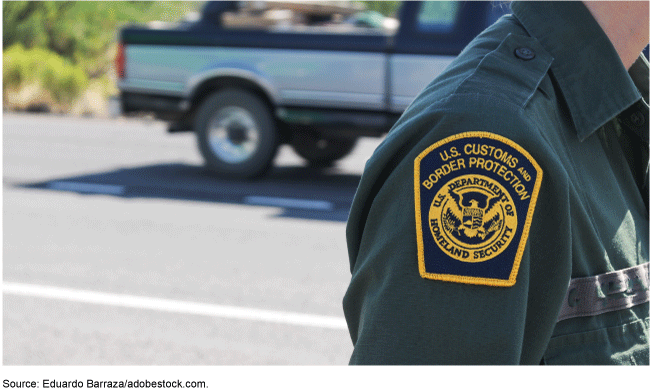U.S. Customs and Border Protection: Efforts to Improve Recruitment, Hiring, and Retention of Law Enforcement Personnel
Fast Facts
U.S. Customs and Border Protection employs more than 45,000 law enforcement personnel. In recent years, CBP has fallen short of staffing targets, while encounters with noncitizens at the border have greatly increased.
Since our 2018 report on this topic, CBP bolstered its recruitment, hiring, and retention efforts. For example, Border Patrol began offering a $20,000 recruitment benefit in 2024, with another $10,000 for work in remote locations. CBP also began an exit survey to inform retention efforts, as we recommended in 2018.
Over the last several years, CBP has generally seen improvements in the metrics it uses to assess its hiring process.

Highlights
What GAO Found
U.S. Customs and Border Protection (CBP) took several actions in recent years to bolster its recruitment efforts. For example, each of CBP's operational components—the Office of Field Operations, U.S. Border Patrol, and Air and Marine Operations—offered recruitment incentives for law enforcement positions. For instance, in 2024 Border Patrol offered recruitment incentives of $20,000 per recipient, with an additional $10,000 for recipients stationed in remote locations. Applications for CBP law enforcement positions generally decreased from fiscal years 2018 through 2022 but increased from fiscal years 2022 to 2023. CBP officials cited several challenges to recruiting personnel in recent years, including a lack of services (e.g., medical facilities) in certain remote CBP locations, the COVID-19 pandemic, and negative public perceptions about law enforcement.
Since GAO's previous report on this topic in 2018, CBP has taken actions to streamline its hiring process, such as moving hiring steps online and allowing applicants to complete certain steps concurrently. CBP also modified the polygraph examination process by revising its restrictions on applicants' prior marijuana use, among other things. CBP's polygraph exam pass rates generally improved following these changes. Over the last several years, CBP generally saw improvements in key metrics it uses to assess its hiring process. For example, CBP reduced its time-to-hire for Border Patrol Agents, though time-to-hire increased for CBP Officers due to a backlog of applications for this position, which has since been cleared. CBP also increased its applicant yield rate—the percentage of applicants who enter on duty—for all law enforcement positions.
Time-to-Hire and Applicant Yield Rates for CBP Law Enforcement Positions, Fiscal Years (FY) 2013 through the Second Quarter of FY 2024
|
Time-to-hire (in days) |
Applicant yield rate |
|||
|---|---|---|---|---|
|
FY 2015–2017 |
FY 2018–2024a |
FY 2013–2017 |
FY 2018–2024a |
|
|
CBP Officers |
360 |
578 |
1.9% |
2.5% |
|
Border Patrol Agents |
403 |
316 |
1.1% |
1.8% |
|
Air and Marine Operations positions |
–b |
288 |
1.0% |
4.0% |
Source: GAO analysis of U.S. Customs and Border Protection (CBP) data. | GAO-24-107029
aFY 2024 data is as of the end of the second quarter of the fiscal year.
bCBP began tracking time-to-hire for Air and Marine Operations positions in FY 2018.
CBP implemented various initiatives to assess and improve retention and morale among law enforcement personnel. For example, CBP offered retention and relocation incentives in certain locations. CBP also implemented an exit survey to inform retention efforts, as GAO recommended in 2018. Further, CBP developed employee health and wellness initiatives as well as plans to address its longstanding morale challenges. While attrition rates generally remained below the federal government-wide average of 6 percent, attrition outpaced hiring for Border Patrol Agents and Air Interdiction Agents in recent years. CBP anticipates a steep increase in attrition rates across all positions starting in 2027 because a significant number of its law enforcement personnel will become eligible to retire. CBP has a strategic plan to address this retirement surge, and retention- and morale-related efforts will be increasingly important to help mitigate the surge.
Why GAO Did This Study
Within the Department of Homeland Security (DHS), CBP is responsible for securing U.S. borders and employs more than 45,000 law enforcement personnel across its three operational components. In recent years, CBP has fallen short of staffing targets, while encounters with noncitizens at the U.S. border have greatly increased.
GAO was asked to review CBP's efforts to recruit, hire, and retain law enforcement personnel since GAO's prior work on this topic in 2018. This report addresses: (1) CBP's approach to recruiting qualified law enforcement personnel, (2) CBP's steps to improve the hiring process for law enforcement positions, and (3) CBP's initiatives to assess and improve retention and morale for law enforcement personnel.
GAO analyzed CBP data on recruitment, hiring, and retention from fiscal years 2018 through the second quarter of fiscal year 2024. GAO also reviewed documentation related to CBP's recruitment, hiring, and retention activities and interviewed CBP officials and employee unions representing CBP law enforcement personnel. GAO also analyzed recruitment, hiring, and retention data and met with officials from four other federal law enforcement agencies. GAO selected these agencies because they have missions and hiring processes that are similar to CBP's.
For more information, contact Rebecca Gambler at (202) 512-8777 or gamblerr@gao.gov.
